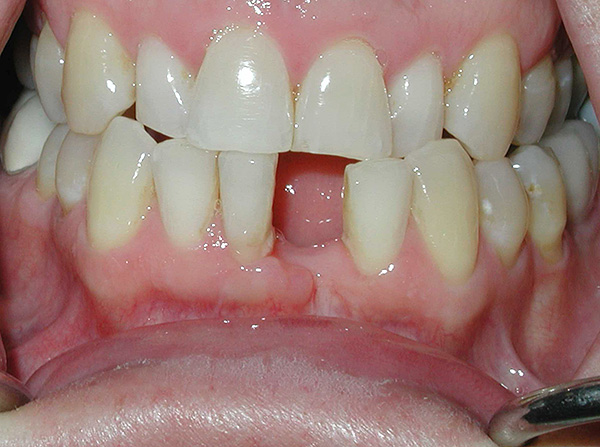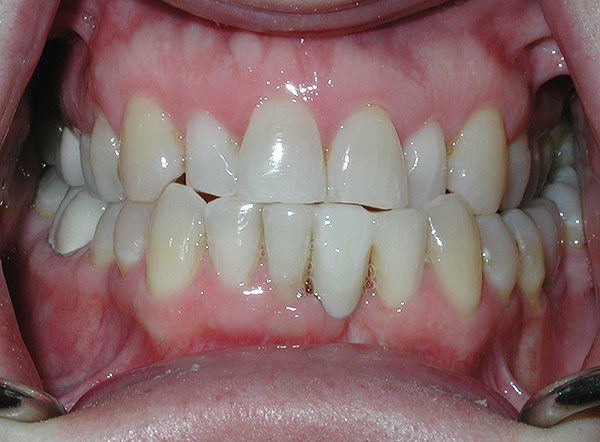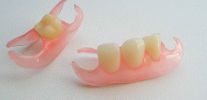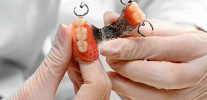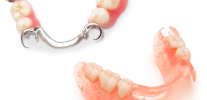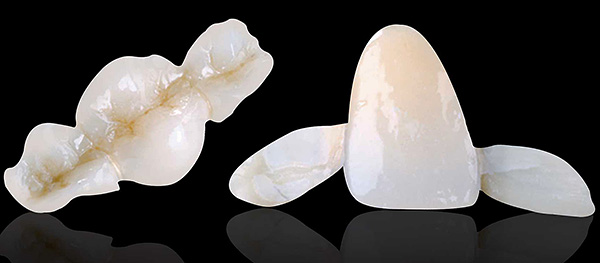
The adhesive bridge is a non-removable structure, which is literally glued to the adjacent teeth using special devices that do not cause interference and do not require removal during further operation. The most important advantage is the absence of the need to grind the teeth adjacent to the defect under the crowns.
At present, adhesive bridges are positioned as a serious alternative to classical bridges - from stamped-brazed to metal-ceramic constructions. When installing a classical bridge, the abutment teeth (sometimes completely healthy) are ground, after which the crowns of the bridge (on cement) are installed on them.
When it comes to prosthetics of several teeth, the use of the classical design is quite reasonable and reasonable, but does it make sense to replace the defect with a standard bridge in the absence of only one tooth? After all, then for the sake of a single defect would have to "cripple" (grind,and sometimes even in addition to de-pulp) two innocent neighboring teeth.
It is worth noting that the loss of one tooth by many people is not taken seriously at first (with the exception, perhaps, of those clinical cases where the defect appears in the smile zone). However, with the loss of any tooth, the integrity of the entire tooth row is disturbed, against the background of which the normal function of chewing food is disrupted and tooth and jaw pathologies of varying degrees of severity (malocclusion and other equally unpleasant consequences) are gradually formed.
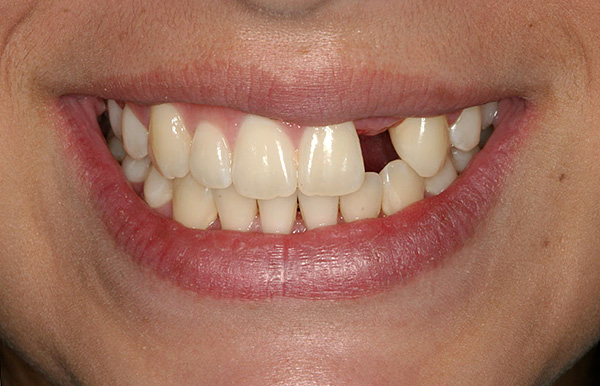
On a note
This is especially true for chewing teeth, which almost always determine the indicators of normal occlusion and the ratio of dentition. With the loss of at least one chewing tooth, its neighbors rather quickly begin to behave “inadequately” - they shift (bend) in the direction of the defect. As a result, the entire dentition can "float".
In order not to be ashamed of a wide smile and not experience discomfort when chewing, it is important to contact your dentist as soon as possible to eliminate the defect through prosthetics. To eliminate a single defect, the following options can be considered:
- The use of prosthesis- "butterfly." But it is removable, which creates inconvenience in operation;

- Prosthetics on the implant. This is the best option in terms of aesthetics and functionality, but usually long (several months) and not everyone can afford it (it will cost about 70-100 thousand rubles);
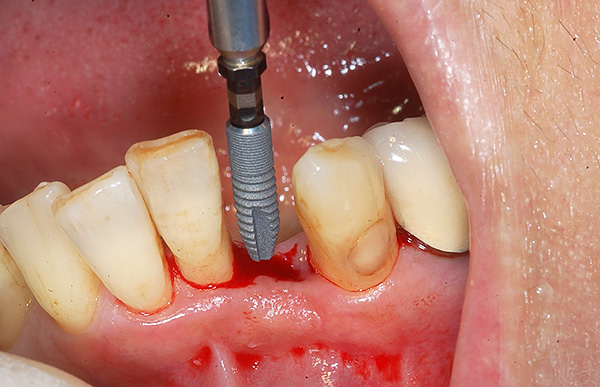
- Classic bridge. As already noted above, it is difficult to call this option the best, since you will have to grind two abutment teeth under the crown;
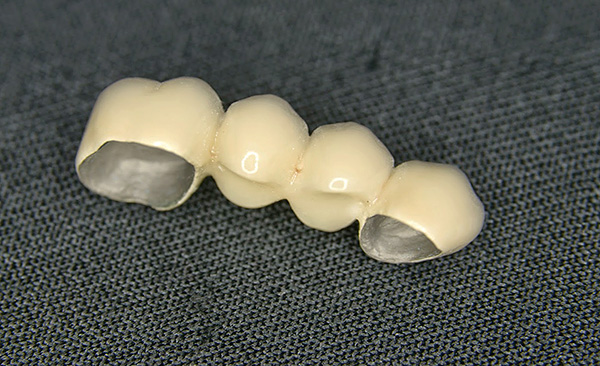
- Adhesive bridge, as an alternative to the standard bridge, suggesting minimal impact on the tissue of the adjacent abutment teeth.
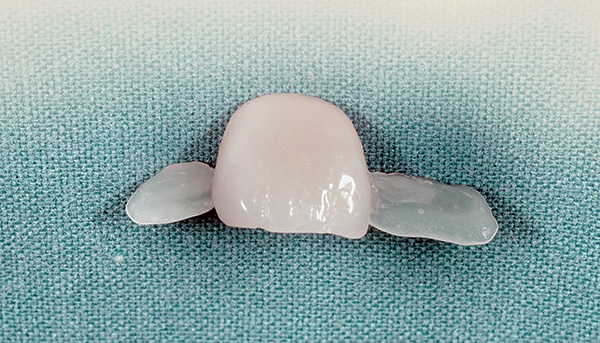
Advantages of adhesive prosthetics
The choice in favor of an adhesive bridge determines, in addition to the indications, four main advantages that can be very attractive, especially against the background of comparison with other types of prosthetics.
These are the benefits:
- Odont-reparation (turning) of the teeth adjacent to the defect is not performed. In other words, for fixing the structure, it is not necessary to remove enamel from the surfaces of healthy teeth, unlike prosthetics with stamped-brazed crowns and, especially, metal-ceramic.In the latter case, the tooth is grinded so seriously that it is often necessary to depulpate it beforehand, that is, to remove the “nerve” so that it does not fall ill under the crown (this is what often stops people from opting for the classical bridge);
- In most cases, even anesthesia is not required. Many people in one degree or another are afraid not only of the toothache that occurs when using a dental drill, but also of even the “anesthetic injection” itself. And since adhesive prosthetics are performed without turning the teeth, the risk of pain with a slight surface effect on the abutment teeth is minimized. The use of anesthesia is possible in special clinical cases and in agreement with the patient;
- The speed of manufacture of the prosthesis - usually lasts from 1 to 3 days. When it comes to prosthetics in one visit, the entire non-removable structure is made in the patient’s mouth from beginning to end. Slightly longer have to wait in cases of adding a laboratory stage of manufacturing a prosthesis;
- Relatively low cost of service. In comparison with other structures of similar functional and aesthetic characteristics (metal ceramics,metalless ceramics, etc.) adhesive prosthesis in most clinics will cost less.
The photographs below show an example of a premolar prosthetics using an adhesive bridge:
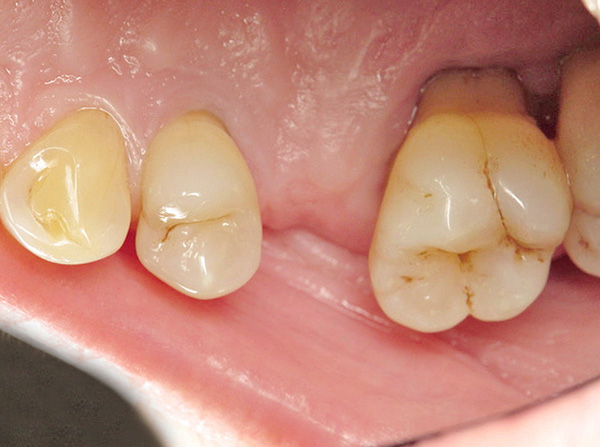
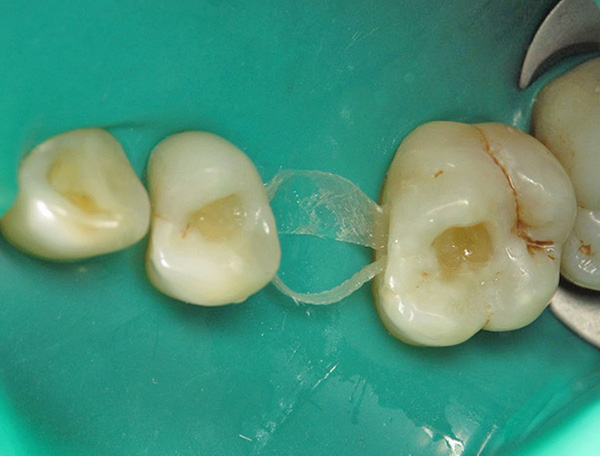
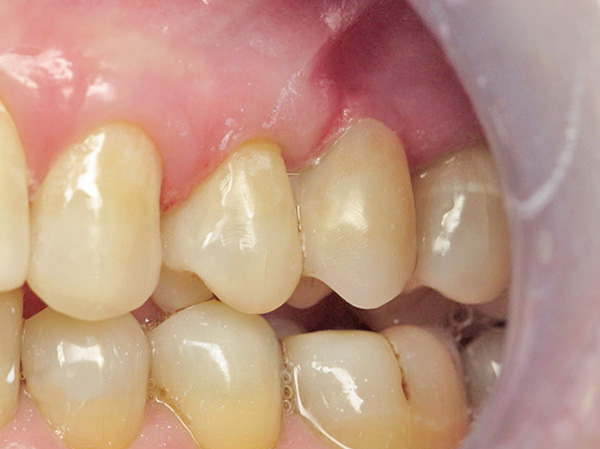
On a note
Adhesion (from the Latin. Adhaesio - adhesion) means adhesion (gluing) of different materials to each other. The adhesive prosthesis is glued to the adjacent teeth with the help of special dental materials. Such a prosthesis is sometimes also referred to as the Maryland Dental Bridge, the Rocheta retainer or the Manhattan Bridge.
In what cases does it make sense to put an adhesive bridge?
The installation of an adhesive bridge is a simple and fast way to eliminate a defect in the dentition, and this method continues to be the leader among other types of prosthetics in terms of speed of implementation. However, despite serious advantages, adhesive prosthetics are far from being used - it has its own indications and contraindications.
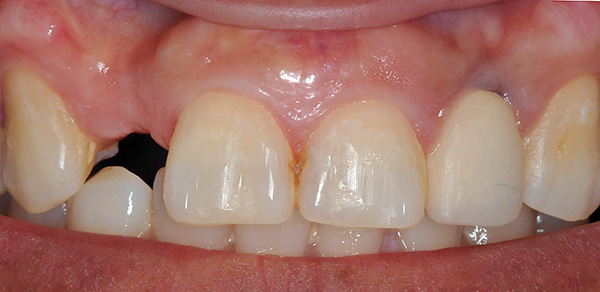
There are few general contraindications for installing an adhesive prosthesis. First of all, it is not recommended to do this construction in persons suffering from epilepsy, as it easily breaks during an attack.
On a note
It should be borne in mind that the prosthesis may break even if you have the habit of biting nails, pens, pencils.
There are also local factors that prevent the use of adhesive prosthesis:
- Significant extent of the defect. In other words, adhesive prosthetics of more than 1-2 teeth has the risks of rapid break-off or bridge cracks. This is especially true for the chewing area, which accounts for the main load during chewing. Today, doctors recommend replacing only 1 missing tooth and best of all in the anterior section, where the load on the teeth is relatively small.. With a large extent of the defect, it may be more appropriate to use a classical bridge or a removable clasp prosthesis (see photo);
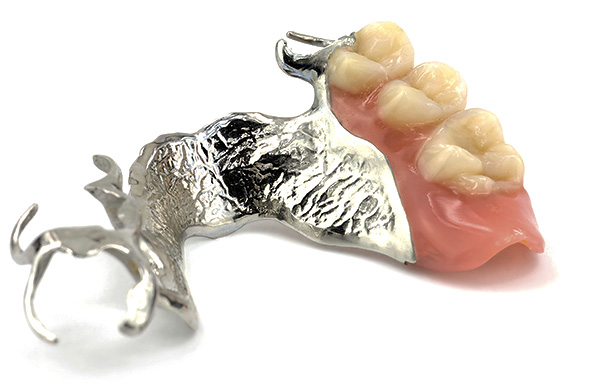
- The abutment teeth have significant defects and (or) are in the wrong position. To carry out adhesive prosthetics in these cases is possible only with appropriate preparation of the teeth and serious orthodontic treatment, therefore sometimes it is more rational to choose another type of non-removable prosthetics, in which you do not have to wait years for a quality treatment, correcting dental anomalies;
- Abutment teeth have mobility or abnormal abrasion.
On a note
Poor oral hygiene in general can also create many problems when using a prosthesis. Poor hygiene in most cases is a serious obstacle to any type of treatment in dentistry, and especially for adhesive prosthetics, since the specificity of fastening the structure while neglecting hygiene products will further contribute to the development of caries in the area of abutment teeth.
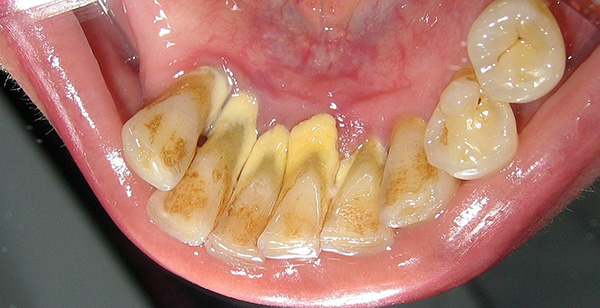
In other cases, adhesive prosthetics may be quite a reasonable decision.
Composite adhesive bridges manufactured directly in the dentist’s chair
The composite composite adhesive in Russia was first learned about the adhesive bridge in Russia thanks to the development of Sergey Radlinsky, which began in the early 1990s. It was his work that initiated the creation of a qualitatively new direction for the restoration of a lost tooth - with the help of ordinary light-cured fillings and special technical devices.
The essence of the idea is very simple: you need to securely glue the artificial tooth to the adjacent abutment teeth. Metal wire can act as an auxiliary fixing device - it is based on the adjacent teeth with the defect, which is the basic basis of the adhesive prosthesis. The process of making such a bridge is as follows: on the enamel of the neighboring teeth, small depressions are created, to which the wire then enters.
Will there be pain at the stage of “drilling” the drill of these artificial furrows?
In practice, most often, anesthesia is not required at all, since the processing of teeth is minimal. In addition, often the abutment teeth on the contact surfaces (closer to the extracted tooth) have fillings, removing which, you can get a good bed for fixing the beam. In a pinch, dentists today have a whole arsenal of anesthetics for reliable pain relief.
A more advanced technology is adhesive prosthetics with fiberglass in the form of tapes and harnesses. In this case, instead of the wire, they are inserted into the formed grooves on the abutment teeth, and an artificial tooth is then reconstructed on them from the composite.

Patients usually wonder if it takes a lot of time for the doctor to “build up” a new tooth in the mouth in one session?
It is worth noting that the creation of an adhesive bridge from a light-cured composite is practically a piece of jewelry that requires from a doctor not only knowledge and experience with such restorations, but also a certain amount of exposure, since one cannot rush into this matter. "Light" materials are applied to the metal beam or fiberglass in small layers with the phased use of special matrices and "formers" of the future tooth. Work can take from 1.5 to 4 hours: precisely the exact fulfillment of all requirements allows you to make a high-quality and reliable bridge.
It is interesting
An artificial tooth made of composite does not lie on the gum - just like classical analogs made of metal and ceramics, the prosthesis has a washing space between the gum and an artificial tooth. The photo below shows how it might look like in life:
Adhesive prosthetics has many similarities with the artistic restoration of a tooth, only in the latter case one's own native tooth is used as a support, and adjacent teeth with beams between them are used to create an adhesive bridge.Ideally, at the end of the work, the tooth cannot be distinguished from its own, since the master recreates all the bumps, pits, grooves, and also imitates the color and even the natural shine of the surface.
Reviewed by one of the practicing doctors:
“I’m generally skeptical about single-step recovery methods such as direct veneers or composite bridges. But if you do, then it is better to choose the manufacture in the laboratory, as they are much stronger compared with the cabinet "creativity", plus better made ... ".
Alexander V., Moscow
Laboratory (indirect) method of manufacturing adhesive bridge
Unlike adhesive prosthetics by the direct method, the laboratory method of obtaining a bridge is more accurate and reliable, because about half of the work is not done in the patient's mouth (this, frankly, not the most favorable conditions), but in the dental laboratory.
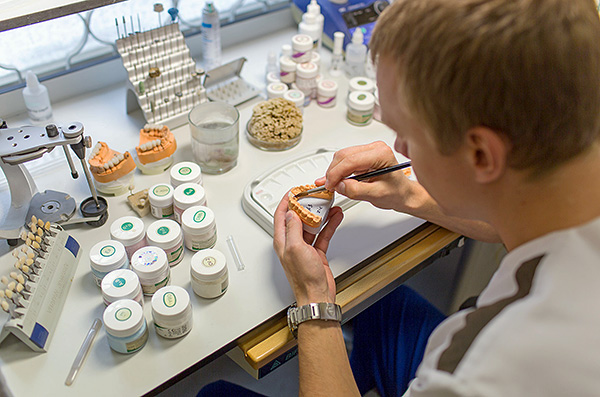
The indirect method of this prosthesis includes 4 main steps:
- Treatment of abutment teeth (different, depending on the clinical situation). This is not a “turning” of a tooth from all surfaces, but a grinding, cutting of grooves, or even the treatment of caries - cleansing the cavity of carious tissues and adapting it to fix the future prosthesis beam.Grinding is important for ensuring good adhesion of the prosthesis to the tooth surface;
- Taking impressions (impressions). With the help of special pasty materials introduced into the oral cavity on spoons, a negative mapping of the surface (relief) of the oral cavity with all the teeth is obtained;
- Prosthesis making. Ceramics and plastics can be used for this. A plastic adhesive bridge is cheaper, but will be much less durable than a ceramic one;
- Fixation of prostheses on abutment teeth with the help of dental cements.
Feedback:
“Recently lost a side tooth (the first after the canine). For a long time there was a crown, but the root was cracked, although I thought it would last until old age. I can not remember without tears, I suffered a lot when the remnants of the root were removed. It was a pity, but she was afraid of prosthetics, as she would have to spoil the neighboring teeth. At the implants did not even waved, very much too expensive. She came to the clinic near the house for the sake of curiosity, but left with a brand new tooth, which was made directly from the filling in just 7 thousand rubles! True, I was told that now it’s not recommended to gnaw hard ... "
Oksana, Novosibirsk
What is useful to know about the disadvantages of adhesive bridges
Despite a number of enthusiastic reviews about the use of adhesive bridges, in addition to significant advantages, they also have serious drawbacks, which are useful to know in advance.
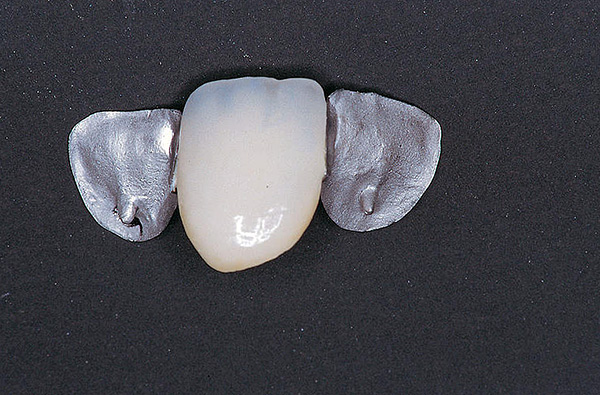
First of all, it should be noted that adhesive prosthetics falls under the category of temporary replacement of a missing tooth. (despite the fact that in a number of clinical cases, this period may be 5-7 years). But, as they say, there is nothing more permanent than temporary, and in Russia (not from a good life) today, many temporary denture structures are used by patients for many years as permanent (artificial limbs, full removable acrylic prostheses, adhesive bridges, etc. )
That is why you should not be surprised that the main disadvantages of the prosthesis are the fragility and fragility of the structure (largely because of this, it is recommended to carry out prosthetics no more than 1 tooth and, if possible, only in the anterior section).
On a note
Adhesive bridges successfully replace and 2 extracted teeth, and even in the lateral section, when there are no molars. However, it is often possible to face situations where all the work goes down the drain in the very first year after prosthetics - because of an apple, a crust of bread, kebabs, etc. That is, even if the dentist makes a prosthesis as close as possible to the original bite, returning the replaced tooth to its function, careless behavior regarding food intake can easily cause breakage at the first opportunity.
From the above, another drawback of adhesive prosthetics follows - the ability to restore mainly cosmetic defects only, without the return of a new artificial tooth to full active work. That is, the tooth will not be fully involved in the load - in the bite, along with other teeth, it simply will not be.
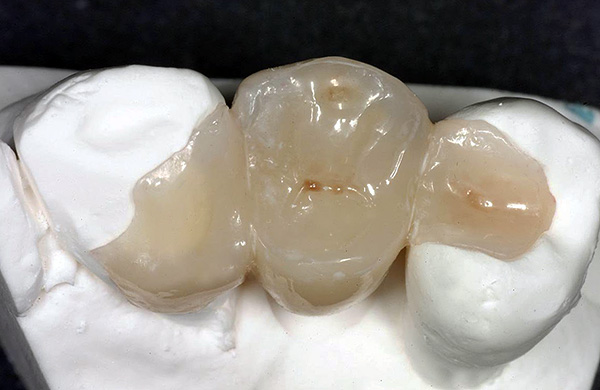
Feedback from a practicing dentist (taken from the dental forum):
“Most of my patients have a negative attitude towards the installation of crowns on the teeth, especially when it comes to intact teeth. This is how the soviet mentality manifests itself, which is very difficult to overcome.I always plan the adhesive prosthesis as a splinting construction and immediately stipulate that it is temporary (albeit LONG-time). And in the future it will be necessary to put a full bridge. Maryland is good to use at a young age as a benign option for prosthetics ... "
George, St. Petersburg
What if the adhesive prosthesis broke anyway?
Depending on the specifics of the problem, there is a help tactic. In some cases, repairing an adhesive bridge is possible, but a highly professional doctor will always take into account the causes of the breakdown.
For example, if the problem with the adhesive structure does not appear for the first time, then this may indicate the effect of excessive load on it due to the nuances of bite. It may well be that there is no point in reworking each time, losing time and money, but it is advisable to make classical metal ceramics or ceramics based on the processed adjacent teeth and forget about the defect for 10-15 years.
What is the final cost of prosthetics
The price of adhesive dental prosthetics is made up of many components.The status of the clinic, the level of organization and equipment of the rooms, as well as the fame and qualifications of staff can have a significant impact on pricing.
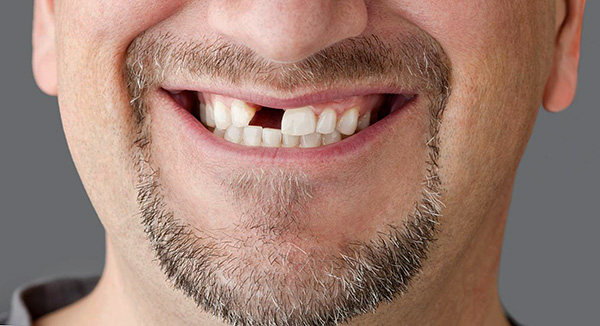
Composite adhesive bridges are much cheaper than their counterparts made by the laboratory method: metal-ceramic and ceramic. In this case, metal-ceramic adhesive structures, in turn, cost less than ceramic (less the cost of materials, lower the complexity of manufacturing technology, but a little less, and aesthetics).
As a result, prices for adhesive dentures vary today from 5 to 30 thousand rubles and more (the cost of "turnkey").
On a note
It may seem surprising that adhesive prostheses sometimes cost more than reliable classical bridges that can stand for more than 10 years without problems. But here we must take into account that people are sometimes willing to pay not so much for the opportunity to chew with artificial teeth for many years, but for the chance to leave the healthy teeth adjacent to a defect not grinded and alive, albeit with the help of a functionally less perfect prosthesis.
If you have personal experience with the use of adhesive bridges - be sure to share the information, leaving your feedback at the bottom of this page.
Interesting video: a good example of making an adhesive bridge from start to finish
What is useful to know about bridges

